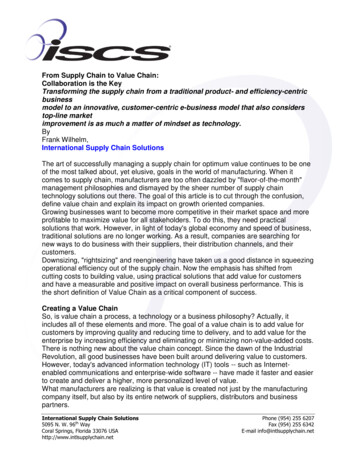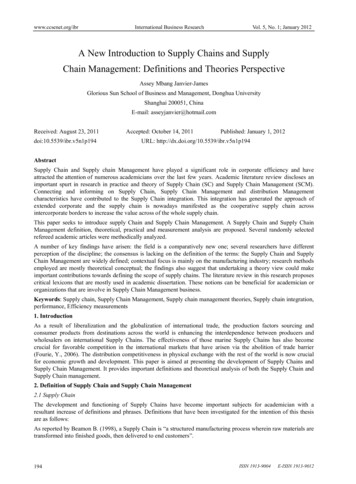
Transcription
From Supply Chain to Value Chain:Collaboration is the KeyTransforming the supply chain from a traditional product- and efficiency-centricbusinessmodel to an innovative, customer-centric e-business model that also considerstop-line marketimprovement is as much a matter of mindset as technology.ByFrank Wilhelm,International Supply Chain SolutionsThe art of successfully managing a supply chain for optimum value continues to be oneof the most talked about, yet elusive, goals in the world of manufacturing. When itcomes to supply chain, manufacturers are too often dazzled by "flavor-of-the-month"management philosophies and dismayed by the sheer number of supply chaintechnology solutions out there. The goal of this article is to cut through the confusion,define value chain and explain its impact on growth oriented companies.Growing businesses want to become more competitive in their market space and moreprofitable to maximize value for all stakeholders. To do this, they need practicalsolutions that work. However, in light of today's global economy and speed of business,traditional solutions are no longer working. As a result, companies are searching fornew ways to do business with their suppliers, their distribution channels, and theircustomers.Downsizing, "rightsizing" and reengineering have taken us a good distance in squeezingoperational efficiency out of the supply chain. Now the emphasis has shifted fromcutting costs to building value, using practical solutions that add value for customersand have a measurable and positive impact on overall business performance. This isthe short definition of Value Chain as a critical component of success.Creating a Value ChainSo, is value chain a process, a technology or a business philosophy? Actually, itincludes all of these elements and more. The goal of a value chain is to add value forcustomers by improving quality and reducing time to delivery, and to add value for theenterprise by increasing efficiency and eliminating or minimizing non-value-added costs.There is nothing new about the value chain concept. Since the dawn of the IndustrialRevolution, all good businesses have been built around delivering value to customers.However, today's advanced information technology (IT) tools -- such as Internetenabled communications and enterprise-wide software -- have made it faster and easierto create and deliver a higher, more personalized level of value.What manufacturers are realizing is that value is created not just by the manufacturingcompany itself, but also by its entire network of suppliers, distributors and businesspartners.International Supply Chain Solutions5095 N. W. 96th WayCoral Springs, Florida 33076 USAhttp://www.intlsupplychain.netPhone (954) 255 6207Fax (954) 255 6342E-mail info@intlsupplychain.net
This realization represents a significant departure from the past. Where once decisionswere made on product quality and price, today's customer also demands a high level ofservice, agility and flexibility, attributes which the old-style supply chain was notdesigned to deliver. The traditional supply chain model is linear and task-oriented, aninternal "command and control" mechanism with cost-cutting and bottom-line efficiencyas its goal. The new value chain model is complex, parallel, and relationship-oriented.Its goals include bottom-line efficiency, but emphasize top-line growth and optimalcustomer service.Today's value chain is held together by a process of collaboration between tradingpartners to redeploy and redistribute costs, risk and profits throughout the chain -- aprocess fraught with challenge. Thinking collaboratively rather than competitively doesnot come easily to most businesses. With no legacy model to draw upon, managementhas to rethink the business from the ground up and may be challenged by internal andexternal fears and negative mindsets as they attempt to create a new and frictionlessenvironment of open communications.Collaboration is the KeyThe value chain process is building a collaborative environment that is flexible andadaptable to changing customer needs. In this new e-business economy, the valuechain transcends traditional enterprise ownership boundaries. Today's CEO andmanagement team must "levitate" outside of their own four walls to form collaborativepartnerships with trading partners, and even customers. This is their best hope forcoping with market and customer volatility. With the walls down and the costsassociated with maintaining those walls eliminated, the enterprise and its partners canfinally focus on what's truly important -- getting products to customers, how, whenand where they want them. Thus, the heart of value chain is neither information norprocess technology. It is the sharing of key information in a parallel fashion to speed upthe cycle time from customer order to delivery.Technology plays a part, of course. With technology-enabled collaboration, automationcan speed up information flow and a wide range of redundant, non-value-added taskscan be replaced with real-time information to all parties.One of the most important steps a company has to take in building a value chain isreforming its relationships with the supply and distribution base. Unless theserelationships are redefined at their very core, attempting to build a value chain will be alesson in futility. Coercivenegotiations must be replaced with collaborative agreements. Adversarial relationshipmust give way to trusting partnerships. In this new paradigm, companies can no longersqueeze their suppliers or pit them against each other based on price. Quite theopposite. Fixation on price will give way to an emphasis on total costs and othercollaborative goals. To create real value forInternational Supply Chain Solutions5095 N. W. 96th WayCoral Springs, Florida 33076 USAhttp://www.intlsupplychain.netPhone (954) 255 6207Fax (954) 255 6342E-mail info@intlsupplychain.net
customers and the enterprise, supply chain members must work as a team -- sharingcosts, risks and profits -- and focus on serving the customer.The Business Side of the EquationTo create an efficient value chain, those things that do not add value must be eliminatedin order to hasten product delivery and reduce costs. In a supply chain of trustedpartners, you can save significant time and costs by eliminating redundant tasks andstreamlining time-consuming processes, such as Purchase Orders, RFQs and otherpartner/manufacturer paperwork. You can also deploy time-saving tactics such asInternet-enabled networks, Vendor Managed Inventories, automatic stockreplenishment and more. Many companies experience real problems when it comes toforecasting and demand planning. They may be good at manufacturing and shippingproducts, but fall short in estimating what customers will want and when. By speedingup and streamlining the demand cycle, manufacturers can gain the flexibility and agilityto deal with market volatility. The key to a responsive value chain is to do things somuch faster and more efficiently that the need for forecasting as a key businessimperative is significantly diminished. Likewise, some companies have adopted a"demand" or "flow" manufacturing mode by rethinking and redeploying supply chainresources to tap into each member's core competencies. For example, they havesuppliers who take over packaging responsibilities and others who look after the entirelogistics area, from warehousing to transportation, shipping and invoicing. The secret isto leverage the capabilities of the team to maximize value.Technology as Enabler, Not DriverRapid information flow enabled by IT may be the "legs" of the Value Chain, but not itsheart. Information access alone is not a solution -- it's what you do with information thatcounts. A company implementing and APS or ERP system may think it is creating avalue chain, but that's an illusion. In fact, even if demand information is made availableto trading partners, if that information is not used to shave time and costs off thedelivery process, then nothing has been gained. Value chain is not about data, butabout relationships. Raw data is meaningless unless effective mechanisms are in placefor using the data, such as vendor stocking, blanket ordering, and customer responsesystems.Lack of supply chain integration is one reason why so many ERP implementations havegone down in flames and many more, while implemented, have severely underdelivered. These failures can usually be tracked to a lack of visibility between the backand front office, or lack of timely communication between the enterprise and itsbusiness partners. It's not the technology that failed, but the relationship between keyelements. How, then, can growth-oriented companies evaluate and select theappropriate technology solutions for building a value chain? First, they need to redefinebusiness processes and supplier relationships towards a customer-focused orientation.Automating bad processes will never yield good results. And, as explained earlier, if youInternational Supply Chain Solutions5095 N. W. 96th WayCoral Springs, Florida 33076 USAhttp://www.intlsupplychain.netPhone (954) 255 6207Fax (954) 255 6342E-mail info@intlsupplychain.net
have not first redefined key partner relationships, just speeding data through the systemwill not have a beneficial effect, and may even do harm.It's important to remember that building a value chain is a business challenge, not atechnology challenge. So don't let the technology or the abundance of choices confuseyou. As with any business challenge, the best approach for a CEO and managementteam is to analyze the company's needs and goals, find out what customers want, focusfirmly on business return, build a cross-functional team and strong business case. Onlythen should you evaluate technology solutions that can enable you reach your goals.Growing Closer to CustomersAnother valuable and long-lasting benefit of building a collaborative value chain is thedramatic improvement it can make in customer service levels. With such a network, theminute something happens with a customer or in the factory, everyone involved isinstantly aware and can act effectively to handle it. Better customer service leads to topline value stemming from increased customer retention, greater market share andincreased revenues. In any business, customer service is whatever customers perceiveit to be. The key to getting close to customers is to extract their definition of value and toimplement processes and technology that can help you organize, analyze, distill anddisseminate customer information in the form of strategic business intelligence.Companies that do this well experience not only higher customer retention, but alsomore effectively demand chain management and e-business enablement.Building a value chain is not a one-time event but rather an evolution. Customers canbe capricious and their perceptions of value change over time. To remain competitive, acompany needs to know what its customers value most. One of the traditional supplychain's biggest flaws is that it forced companies to focus on the mechanics of productionto deliver quality and price when what customers sorely wanted was personalizedservice and on-time delivery.Evolving Towards Value Chain: A Journey Worth TakingBuilding a value chain is not an overnight process. Rather, it is an evolutionary journeythat involves changing the way the company does business, streamlining the processesinvolved in delivering product, and applying technology solutions where they make goodbusiness sense.The successful companies of tomorrow will be those that manage to keep customershappy, while building bridges with the supply and distribution base to deliver value,however their customers define it. They will be vigilant enough to detect change andagile enough to respond quickly. Today's customer needs to be in control. If they arenot, they are gone. At today's speed of business the admonition to "Be One with theCustomer" is more than just a slogan -- it's an imperative to compete. Responsivenessto customers is the new path to prosperity, and collaboration is the ideal way to getthere.International Supply Chain Solutions5095 N. W. 96th WayCoral Springs, Florida 33076 USAhttp://www.intlsupplychain.netPhone (954) 255 6207Fax (954) 255 6342E-mail info@intlsupplychain.net
Frank Wilhelm, National Director of Supply Chain Management ConsultingInternational Supply Chain SolutionsAs the founder of International Supply Chain Solutions, Frank Wilhelm oversees allaspects of the company’ supply chain management consulting practice with a focus onservice level enhancements, cost reduction and inventory optimization. Wilhelm bringsto this position over twenty-five years of first-hand experience in all facets of integratedsupply chain and materials management. He is a long-standing member of the Board ofAdvisors for the College of Supply Chain Management at Michigan State University anda frequent speaker at educational institutions and industry conferences.Previously Wilhelm Managed the Supply Chain Business Unit at Wave-Bend Solutions,LLC, additionally Wilhelm held the position of Supply Chain Business Unit Manager atCambridge Technology Partners. In that role, he was responsible for sales, marketing,product development, public relations, and infrastructure as the New England-basedsolutions provider looked to him to develop and market its new supply chain business.Wilhelm was also President of the Process Management Group, a west coast consultinggroup that implemented and integrated supply chain management applications withbusiness processes. Frank has held senior materials, logistics and supply chainmanagement positions at Siemens, Rockwell, Alcatel, Digital Equipment Corporationand Motorola.Wilhelm earned his Bachelor of Science in Business Management from the University ofNebraska.International Supply Chain Solutions5095 N. W. 96th WayCoral Springs, Florida 33076 USAhttp://www.intlsupplychain.netPhone (954) 255 6207Fax (954) 255 6342E-mail info@intlsupplychain.net
International Supply Chain Solutions Phone (954) 255 6207 5095 N. W. 96th Way . Collaboration is the Key Transforming the supply chain from a traditional product- and efficiency-centric business model to an innovative, customer-centric e-business model that also considers . enterprise by increasing efficiency and eliminating or minimizing .











